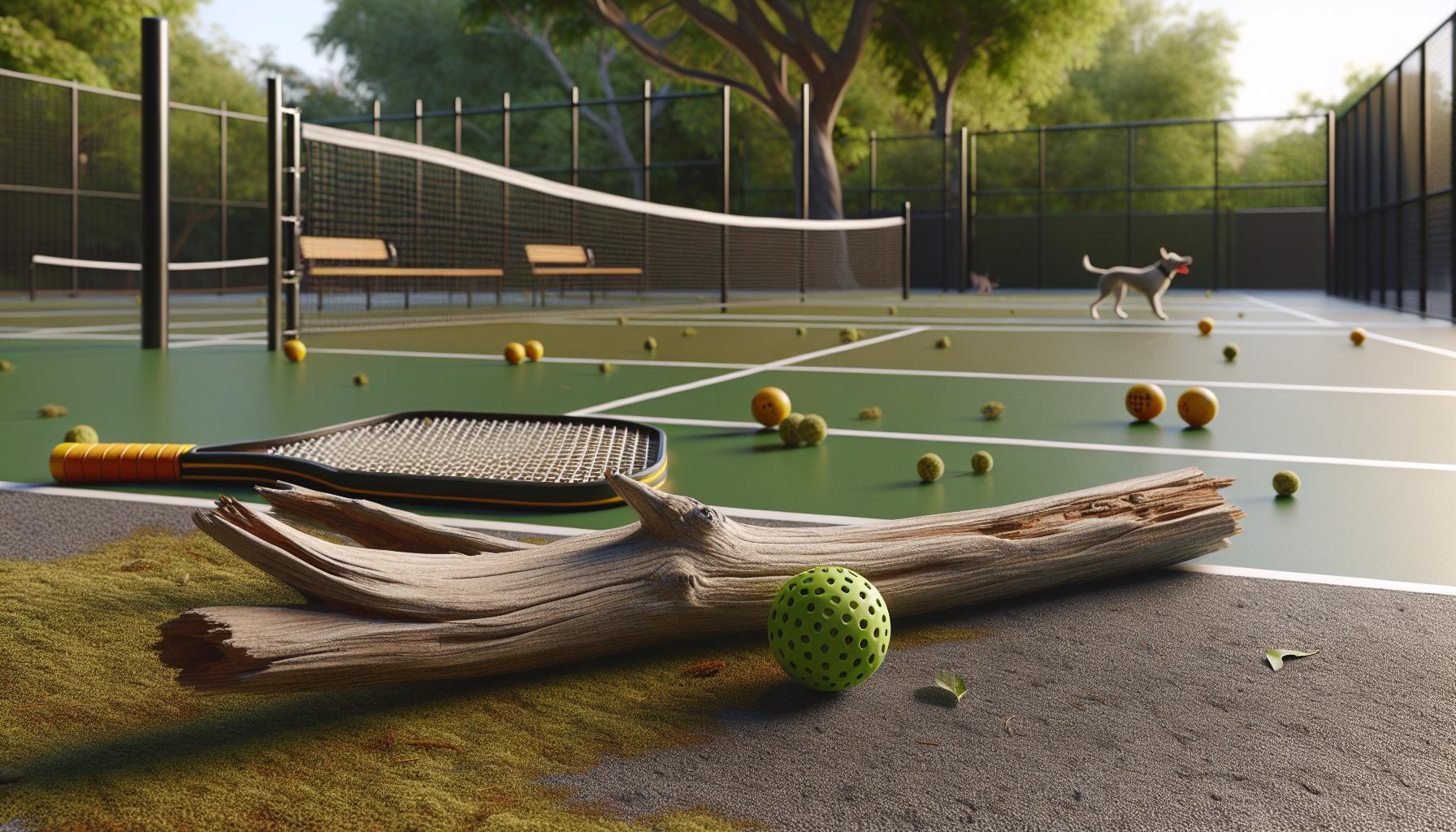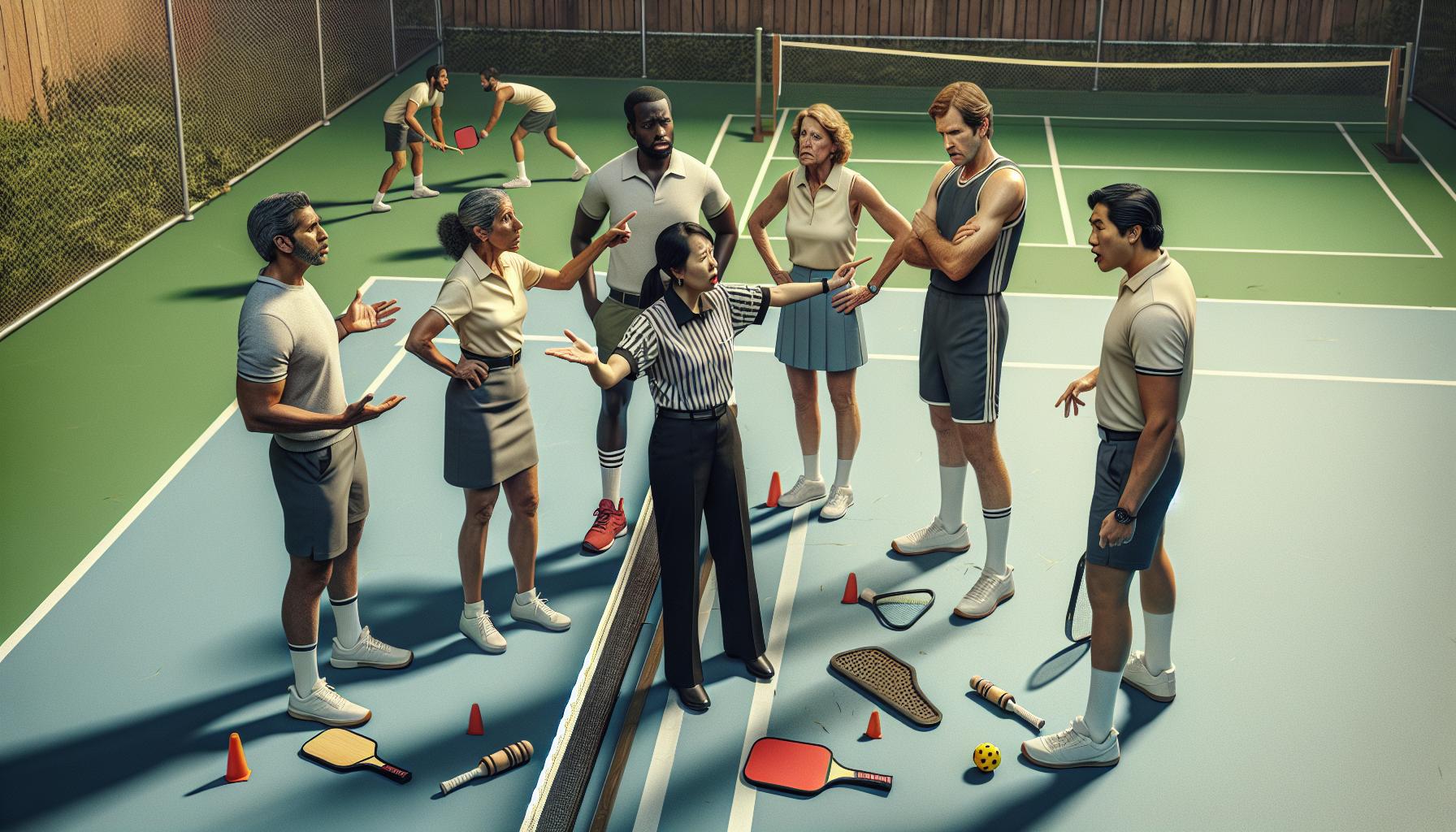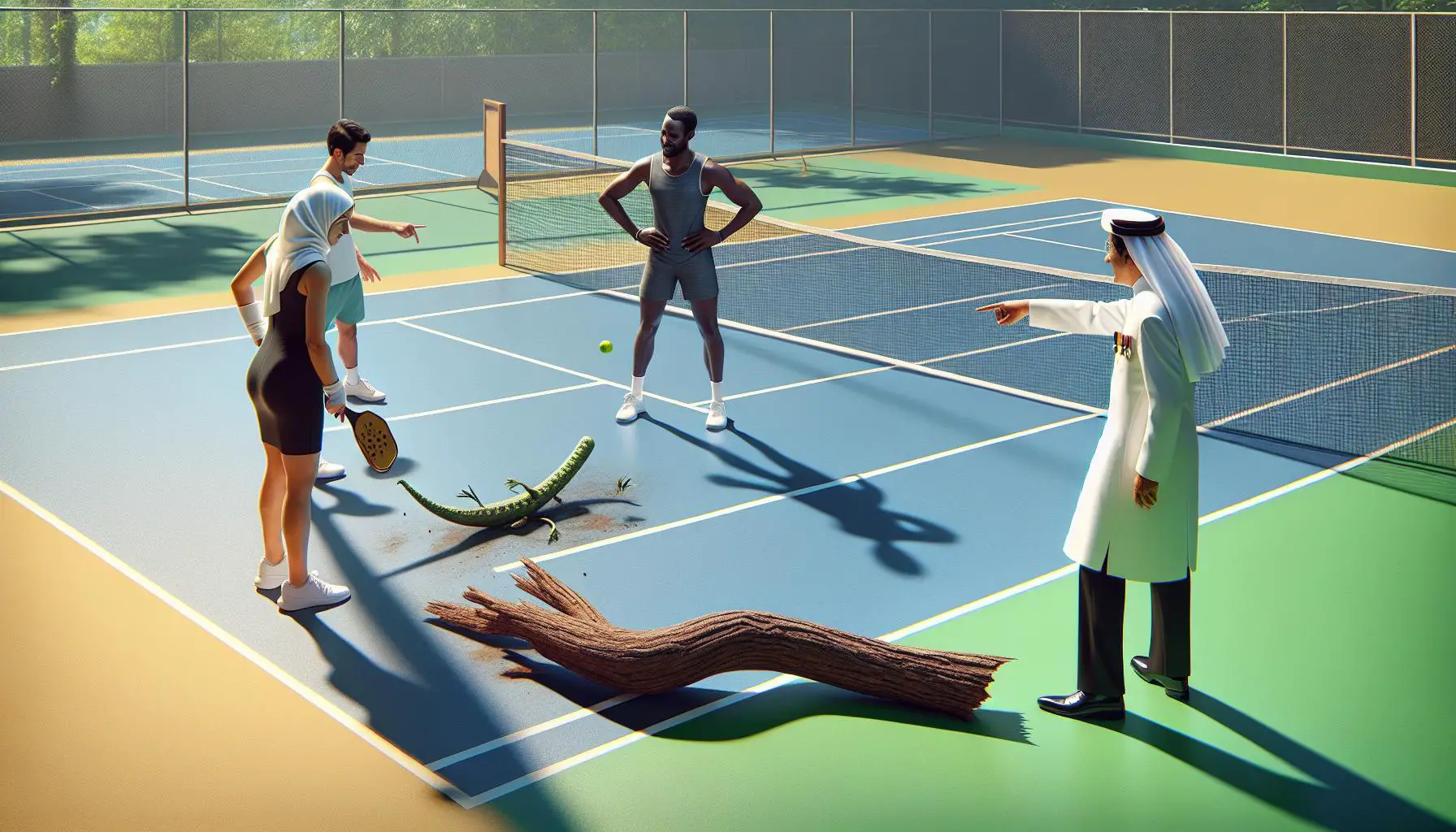Pickleball’s skyrocketing popularity brings players of all ages to the court, eager to serve, volley, and score. But what happens when unexpected guests like stray balls or fallen branches crash the party? Temporary obstructions can turn a smooth game into a chaotic puzzle, leaving players scratching their heads.
Luckily, pickleball rules offer clear guidance on how to handle these unforeseen visitors, ensuring the game remains fair and fun for everyone. Whether it’s a rogue ball from the neighboring court or a surprise puddle, knowing how to navigate these interruptions keeps the spirit of the game alive. Let’s dive into the rules that help maintain order amidst the unexpected.
Understanding Temporary Obstructions
When it comes to pickleball, a game renowned for its easy-to-learn rules and engaging play, temporary obstructions on the court can add an unexpected layer of strategy and amusement. These interruptions often come in the form of stray balls from other games, fallen branches, or even an occasional wandering pet. Navigating these obstacles is not just a matter of luck; it involves a clear understanding of the rules that govern such interruptions.
First and foremost, it’s essential to recognize that temporary obstructions are treated differently from permanent fixtures such as fences or nets. While the latter are considered part of the game’s environment, temporary obstructions offer a unique challenge. Players must be prepared to quickly adapt their strategies without losing focus on their game.
According to the official rules, when a ball is in play and a temporary obstruction occurs, the point is typically paused and replayed. This ensures that no player gains an unfair advantage due to the unexpected interference. However, the specific handling of these situations can vary slightly depending on the level of play and the agreement between players or teams before the game begins. Establishing clear expectations ensures that everyone remains on the same page and that the game’s competitive integrity is maintained.
| Type of Obstruction | Action Taken |
|---|---|
| Stray pickleball | Replay the point |
| Fallen branch | Remove if safe, then replay the point |
| Wandering pet | Pause and safely escort off the court |
It’s also worth noting that player safety is paramount. If an obstruction poses any risk, players are encouraged to stop the game immediately. This proactive approach not only prevents potential injuries but also reflects the spirit of pickleball—a sport that values fun, fairness, and sportsmanship above all.
For recreational play, temporary interruptions often become a part of the game’s social aspect, allowing players to interact and share a laugh before resuming play. In more competitive settings, understanding and promptly addressing these obstructions can mean the difference between losing focus and leveraging the pause to strategize for the next play.
Common Types of Temporary Obstructions

Pickleball, a sport that combines elements of tennis, badminton, and table tennis, has rapidly gained popularity. Its simple rules and engaging play make it accessible to players of all ages. However, just like any outdoor game, pickleball courts can be subject to temporary obstructions that can affect gameplay. These can range from natural occurrences to unforeseen interruptions. Understanding these common obstructions can help players adapt quickly and maintain the flow of the game.
Stray Balls from other courts are perhaps the most common intrusion. Pickleball courts are often located in clusters, and with the sport’s growing popularity, adjacent games can lead to balls rolling onto your court. This not only poses a safety risk but also interrupts the pace of the game. Players should always be alert to the possibility and ready to pause play.
Fallen Branches and Natural Debris can also create temporary obstacles, especially in areas surrounded by trees or in the aftermath of windy weather. While these might not occur as frequently as stray balls, they necessitate a quick clearance from the court to prevent accidents and ensure fair play.
Wandering Pets can add an unexpected twist to any game. Whether it’s a curious dog from the neighborhood or a pet belonging to one of the players, animals can swiftly become obstructions if they wander onto the court. Their safety, as well as the players’, needs to be considered when this happens.
Lastly, Equipment Mishaps, such as a broken paddle or a wayward hat or sunglasses, can also momentarily hinder the game. These are not only distractions but could potentially affect the outcome of a point if not quickly resolved.
Players encountering these obstructions have a collective responsibility to address the issue promptly and safely, ensuring the game can continue with minimal disruption. The anticipation and handling of such interruptions can indeed add a layer of strategy and camaraderie to the sport, emphasizing the importance of sportsmanship and adaptability.
The official rules of pickleball provide a framework for dealing with these temporary obstructions, highlighting the need for immediate action and the retaking of points as necessary. Whether in a recreational setting or a competitive match, the approach to these interruptions requires a balance between maintaining the integrity of the game and ensuring the safety and enjoyment of all participants.
Protocol for Handling Temporary Obstructions

When playing pickleball, encountering temporary obstructions on the court can disrupt the flow of the game and may even pose safety hazards. Recognizing and managing these interruptions promptly is key to maintaining fairness and player safety. Here’s what players and officials should know about handling temporary obstructions.
Immediate Action
Upon noticing an obstruction on the court, play should halt immediately. This action ensures everyone’s safety and prevents potential injuries. It’s crucial for players to stay aware of their surroundings and signal any interruptions by calling out “ball on court” or a similar warning to alert others.
Determining Point Replay or Continuation
After stopping the game due to an obstruction, players must decide whether to replay the point or continue from where the game was interrupted. The decision largely depends on:
- The nature of the interruption
- The point in gameplay when the interruption occurred
- Mutual agreement between players or teams
If the obstruction significantly impacted the play, a point replay is usually the fairest course of action.
Clearing the Obstruction
Before resuming play, ensure the obstruction is completely cleared from the court. Whether it’s a stray ball, fallen branch, or wandering pet, removing the obstacle quickly is important for safety and to get the game back on track. Players should not resume play until everyone agrees the court is safe.
Official Rules
Players should familiarize themselves with the official rules regarding obstructions. The USA Pickleball Association (USAPA) offers clear guidelines on handling interruptions during competitive and recreational play. Specifically, the rules state:
- Play should stop immediately when an obstruction enters the court.
- A point can be replayed if the obstruction occurs during a point.
- If an external object interferes with a playable ball, the point should be replayed.
Communication and Sportsmanship
Effective communication among players is essential when dealing with temporary obstructions. Players should discuss and agree on the best way to handle the interruption, whether it’s replaying the point or continuing from a specific moment. Demonstrating good sportsmanship by being fair and respectful in these discussions ensures that the game remains enjoyable for everyone involved.
Player Responsibilities during Temporary Obstructions

When a game of pickleball is in full swing, an unexpected twist can come in the form of temporary obstructions on the court. These can range from a stray ball from another game to debris or even a sudden appearance of a person or animal. During such instances, players hold the responsibility to ensure the game’s integrity and safety adhere to accepted norms. Recognizing and acting upon these obstructions is pivotal for the continuation of a fair and injury-free match.
Firstly, immediate action is crucial. Players should halt the game at the first sight of any obstruction. This swift pause helps prevent potential injuries that could occur from tripping over or running into the obstruction. It’s not just about stopping; players need to communicate effectively with each other and any officials present to decide on the best course of action.
After stopping play, the next step involves deciding whether to replay the point or continue from where the game was interrupted. This decision depends on several factors, such as the nature of the obstruction, its impact on the point being played, and mutual agreement among the players. It’s important to remember that sportsmanship and fairness should guide this decision-making process.
Clearing the obstruction promptly is also part of player responsibilities. If the obstruction can be quickly removed without hindering the game, the players should do so to facilitate the continuation of play. Examples could include moving a stray ball to the sidelines or gently guiding a lost pet off the court. However, if the obstruction is more complex or requires intervention from facility staff, players may need to pause the game for a longer period until the issue is resolved.
Effective communication is a cornerstone of handling temporary obstructions. Players must voice their observations and concerns clearly to ensure all parties understand the situation and the actions being taken. This includes talking to opponents, teammates, and any onlookers or officials who can assist in resolving the issue promptly.
Understanding the official rules set forth by the USA Pickleball Association (USAPA) regarding temporary obstructions is indispensable. These rules offer guidance on how to proceed in specific scenarios, providing a framework that ensures consistency and fairness. Familiarity with these rules aids players in making informed decisions that align with the spirit of the game.
Penalties for Ignoring Temporary Obstructions

When players encounter temporary obstructions during a pickleball game, they’re faced with more than just a pause in play—they’re also at a crossroads where the right decision can maintain the game’s integrity, while the wrong one can lead to penalties. Ignoring these obstructions isn’t taken lightly in the realm of pickleball, and the rules set by the USA Pickleball Association are clear on the matter.
For starters, ignoring temporary obstructions not only poses a risk to player safety but also violates the spirit of fair play that pickleball is known for. It’s critical for players to understand that not addressing these obstructions can lead to a series of penalties, depending on the level of play and the seriousness of the oversight.
In most casual games, the immediate consequence is a loss of the point currently being played. This rule encourages prompt attention to any disruptions and ensures that no team gains an unfair advantage from an overlooked obstruction. However, in more organized or competitive settings, the penalties can escalate:
- First offense: Warning and loss of point
- Second offense: Loss of serve
- Third offense: Deduction of game points
The table below outlines a general overview of how penalties might be applied in competitive play.
| Offense | Penalty |
|---|---|
| First | Warning + Loss of Point |
| Second | Loss of Serve |
| Third | Deduction of Game Points |
It’s important for players to remember that these penalties are not just about the momentary impact on the game. They serve as a reminder of the importance of safety and fairness—a reflection of the broader ethos of pickleball. Teams are encouraged to collaborate not only within their ranks but also with their opponents and the official (if present) to address any temporary obstructions swiftly and effectively.
Given the potential consequences, it’s in everyone’s best interest to stay vigilant and proactive about removing or reporting obstructions as they appear. Whether it’s a fallen branch, a stray item from spectators, or any other unpredictable element that finds its way onto the court, dealing with it immediately is paramount.
Conclusion
Navigating temporary obstructions on the pickleball court isn’t just about keeping the game flowing—it’s about safeguarding the spirit of competition and ensuring everyone’s safety. The penalties for overlooking these disruptions remind players that fairness and safety are paramount. Whether it’s a casual match or a competitive tournament, the responsibility falls on everyone involved to address any issues promptly. By staying alert and cooperative, players can continue to enjoy pickleball while upholding its core values of fairness and safety.














0 Comments